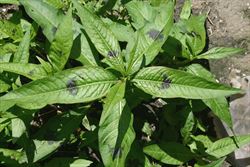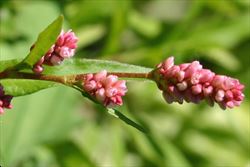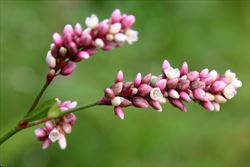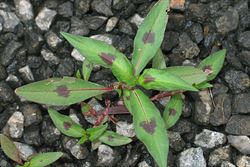Click on images to enlarge

habit (Photo: Trevor James)

the reddish-coloured stems (Photo: Jackie Miles)

leaves with darker blotches (Photo: Trevor James)

slightly elongated flower clusters (Photo: Trevor James)

close-up of paler pink flowers (Photo: Trevor James)

close-up of seedling (Photo: Trevor James)

young plant (Photo: Jackies Miles)
Scientific Name
Persicaria maculosa Gray
Synonyms
Polygonum persicaria L.
Family
Polygonaceae
Common Names
Jesus plant, lady's thumb, lady's-thumb smartweed, persicaria, red shank, redshank, spotted lady's thumb, spotted lady's-thumb, spotted ladysthumb
Origin
Native to northern and central Asia (i.e. Russia, Armenia, Azerbaijan, Georgia, Kazakhstan, Kyrgyzstan, Tajikistan, Turkmenistan, Uzbekistan), the Indian Sub-continent (i.e. Nepal), and eastern Asia (i.e. China, Japan, Korea, Taiwan and Indonesia).
Naturalised Distribution
Widely naturalised in southern Australia (i.e. in some parts of eastern New South Wales, in Victoria, in Tasmania, in south-eastern South Australia and in the coastal districts of south-western Western Australia).
Notes
Redshank (Persicaria maculosa) is regarded as an environmental weed in Victoria and it is seen as a potential threat to one or more vegetation formations in this state. It also appears on some local environmental weed lists (e.g. in Knox City and Mornington Peninsula Shire) and has been recorded in conservation areas (e.g. Organ Pipes National Park and Yarra Bend Park) in Victoria.
This species is usually not treated as an environmental weed in other states, where it is mainly seen as a weed of crops, roadsides and disturbed sites. However, it has been recorded growing in disturbed natural vegetation in Western Australia.

